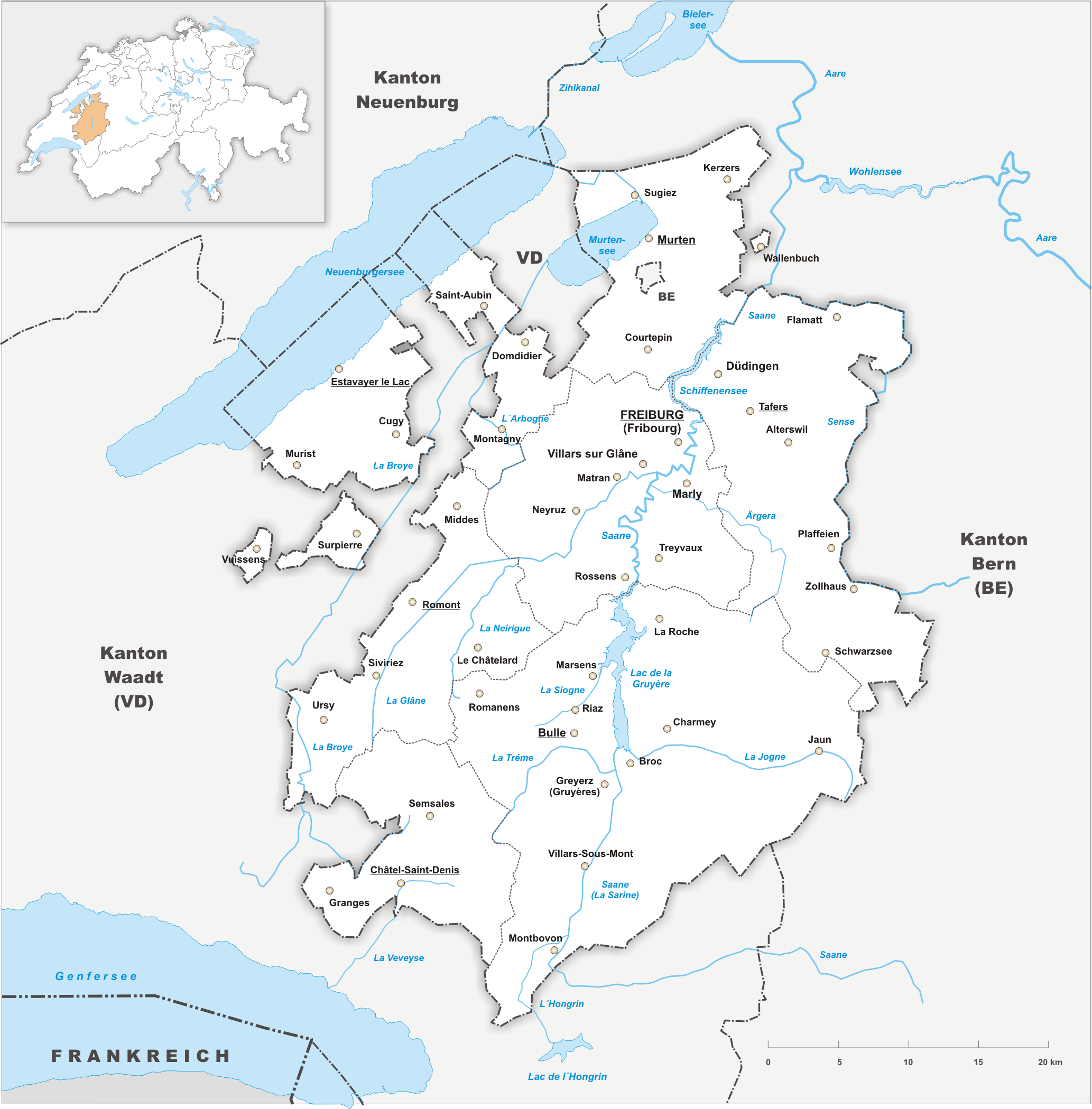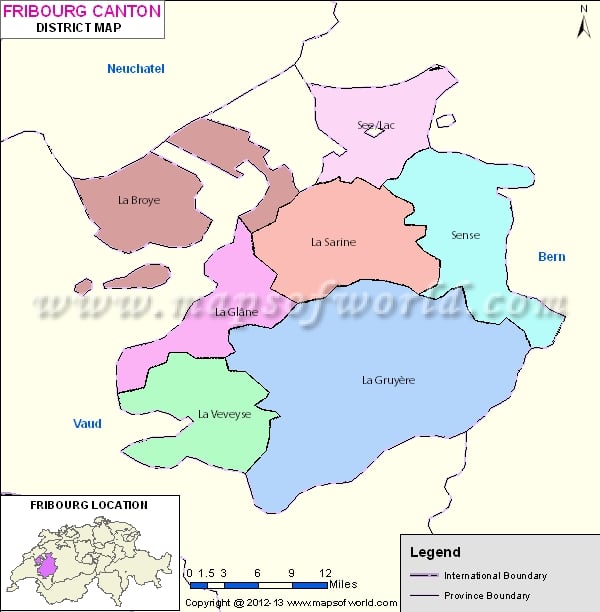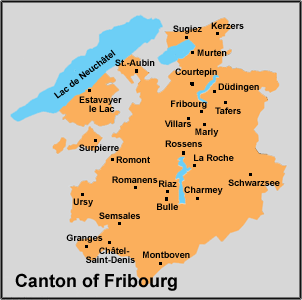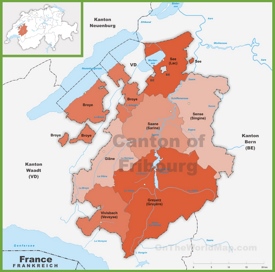Canton of Fribourg
46.7237.061Koordinaten: 47 ° N, 7 ° E; CH1903: 571130/174714 Freiburg (? Swiss German Fryburg, French Fribourg, Italian Friburgo, Romansh Friburg, Franco- le Tyinton de ' Friboua / i ), officially State of Fribourg and Etat de Fribourg [ eta də fʀibuʀ ], is a French-and German-speaking canton in the west of Switzerland. The capital is the city of Freiburg.
- 4.1 Constitution
- 4.2 legislative
- 4.3 executive
- 6.1 communities
Geography
The Canton of Fribourg is 1,671 square kilometers of the eight largest canton in Switzerland. Topographically Freiburg can be divided into two major areas: the northern and western part belongs to the Swiss Plateau, the south to the Swiss Alps. See the main article Fribourg foothills.
The highest elevation is the Vanil Noir with 2389 meters. It is located in the south of the canton in Greyerzbezirk, on the border with the Canton of Vaud. The lowest point is at 430 meters, on Lake Neuchâtel (Lac de Neuchâtel ).
The neighboring cantons of Vaud in the west and south, the canton of Bern in the east, and is bordered to the north by Lake Neuchâtel Fribourg to the canton of Neuchatel.
Coat of arms
As cantonal coats of arms of the black -and-white shield was used until late. End of the 19th century, the coat of arms was created with today's form ( previously supported by one or two lions ).
Black and white coat of arms as was first used with a white cross on a black field. In the resulting four screens in the black field symbolized the four Stadtpanner (Au, Castle, New Town, Hospital), who were the reigning houses of the state. The cross was removed in the course of time from the arms, which led to today's black and white.
Until the collapse of the Stadtpanner the coat of arms was used in connection with the cantonal coat of arms, which led to the old Canton colors black and blue.
Population
The Canton of Fribourg has 291'395 inhabitants (as at 31 December 2012). He belongs to the medium-sized cantons of Switzerland. The population density is 174 inhabitants per square kilometer below the Swiss average. The proportion of foreigners is 20.6 percent. Of the total population 24 per cent are under 20 years old, 62 percent of 20 - to 64- year and 14 percent are older than 64
In the last ten years, the Canton population has increased by 13.1 percent. This Freiburg is one of the fastest-growing cantons of Switzerland. According to the Federal Statistical Office, it is expected that the population will have grown to over 300,000 in 2017. In 2007 Freiburg was an increase of 1.9 percent of the fastest-growing canton of Switzerland.
Languages
The Canton of Fribourg is an officially bilingual canton, the official languages are French and German. The majority of the population is French-speaking, German is spoken mainly in the north and northeast of Canton. In these German-speaking areas, it is this above all the sense and the Lake District, the vernacular is the Senslerdeutsch, in the lake district - according to the history of Murtenbiets as privates reign of Bern and Fribourg - Bern the German.
- Main Language (2000 ) (Source: Federal Office of Statistics) French: 63.2 %
- German: 29.2%
- Portuguese: 1.8%
- Remaining languages: 5.8%
Religions
Freiburg is a Roman Catholic embossed Canton, even though he is surrounded by the majority of Protestant cantons of Vaud and Bern. Only in the north -west of Canton, in the lake district, the majority of the population is traditionally Protestant, since the area until 1798 was a Common reign of Bern and Fribourg. Today, about 70 percent of the cantonal population are Roman Catholic and 15 percent are Protestant. Catholics belong to the Catholic Church nationwide ecclesiastical authority of the canton of Fribourg (French Corporation ecclésiastique catholique du canton de Fribourg ) and religiously to the diocese of Lausanne, Geneva and Fribourg. The Reformed are united in the Evangelical Reformed Church of the Canton of Fribourg. 3 per cent belong to another Christian religion, the others have a different religion, are non-denominational or did not enter the Census.
Policy
Constitution
In 2004 a new State Constitution was adopted, replacing the old one, dating back to the year 1856 and since then 40 times revised constitution.
Legislature
The Grand Council since the entry into force of the new constitution still counts 110 seats. A parliamentary term lasts five years. The elections will be held in the proportional representation method. The last Grand Council elections took place on November 13, 2011.
Executive
The cantonal government is formed by the seven-member Council of State ( Conseil d' Etat). This is appointed every five years by Majorzwahlverfahren.
History
The Pré de Riva is a reconstructed lake-dwelling in Gletterens at Vallon, south of Lake Neuchâtel. On the northern side only about 26 kilometers away, in the canton of Neuchâtel ( at the level of A5 - tunnel ), a further archaeological park Laténium in Hauterive, east of Neuenburg (Neuchâtel), which has taken the place of the " Musée cantonal d' archéologie » and Latène evidence indicates.
Cities and towns
Note the two bilingual cities of Freiburg ( Fribourg French ) and Murten ( Morat French ), along with the other historic district capitals Tafers (French Tavel ), Bull, Romont, Estavayer -le- Lac and Châtel -Saint- Denis.
The canton is divided into a rural south / southeast and one urbanized, densely populated north / northwest. The largest cities are Fribourg and Bulle. The agglomeration of Freiburg im north of Canton has about 96,000 inhabitants and that of Bulle in the South circa 24,000 (both 2004). Moreover, the agglomeration of Freiburg is one of the metropolitan region of Bern. The western part of the Sense district forms the German-speaking part, and almost all the French-speaking district of Sarine. For the agglomeration include only municipalities of La Gruyère Bulle.
Communities
Overall, the canton comprises 165 municipalities (as of January 2012).
Listed below are municipalities with more than 5,000 inhabitants as of 31 December 2012:
Districts
The canton is divided into seven districts:
¹ (French with the only German-speaking congregation Jaun )
It is striking that each district is named after a body of water ( lake is Lake Murten ).
Partnerships
- Mar del Plata, Argentina










